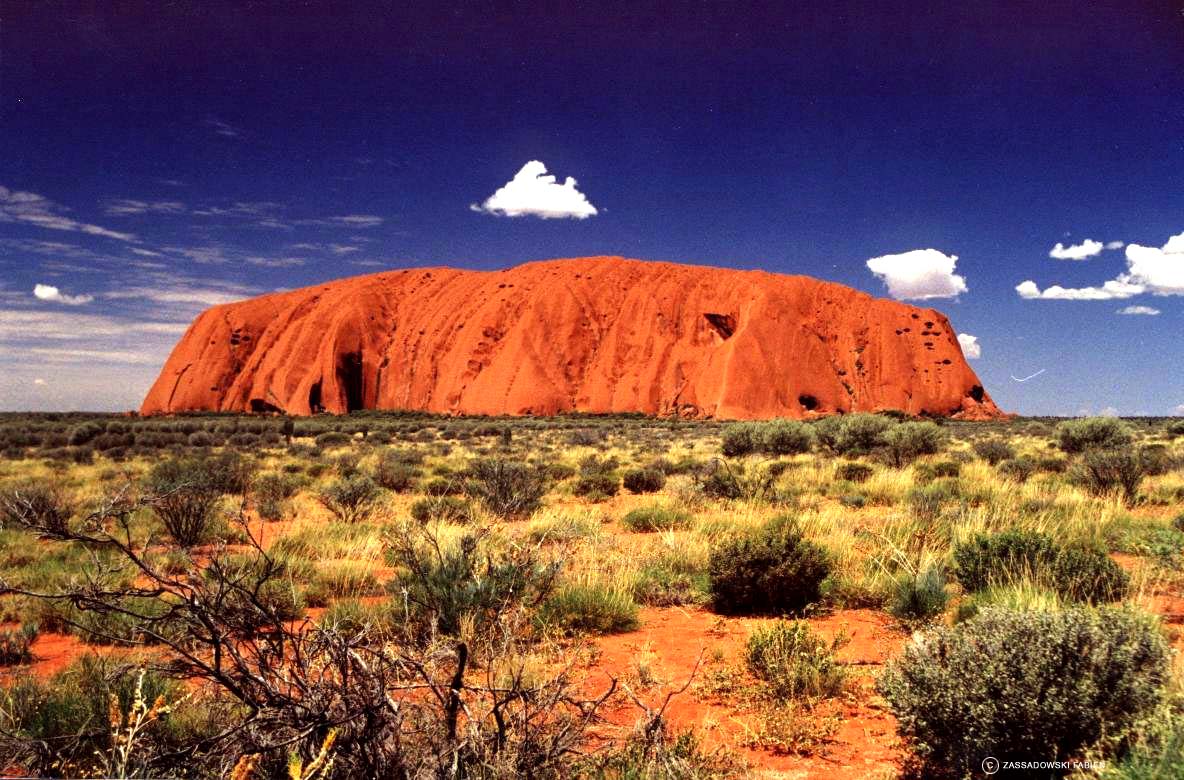Uluru (translated: "shady place") is located in Australia and is probably better known by the names that gave him his first white explorers: Ayers Rock. He is in the thick in the Red Centre, right in the middle of the vast red desert in the center of the continent.
Apart from its sublime beauty and variety of colors, which he runs through the course of each day, is above all a most interesting to him:
Uluru from the air is a huge monolith. Not to say: almost the largest monolith in the world. So, to be exact, the second largest contiguous stone. For a long time he was held even for the largest but it turned out, that is Mt Augustus a little giant - where this is? - Well, certainly in Western Australia ...
Whatever the case - he's definitely the most fascinating!
Uluru is about 4 ½ miles long, wide, 2 ½ km, and 348.7 meters high - and this is only its smallest part, because most of it is still buried.
Actually he is a huge piece of sedimentary rock (like sandstone).
Before about 600 million years ago was a huge mountain range removed slowly and was deposited in a layer.
Last ray of sun on the horizon, and a huge piece of this plateau is broke then just turned off so and also by about 75 degrees. We see today, the deposit layers of different ages - so, yes, strictly speaking, actually its height - ah - depth?
He is not alone the way around there. Just under 60km our suite are the Olgas, a piece from another layer that shows signs of erosion even clearer than her famous brother.
Aerial view of Ayers Rock, Uluru is yes NTGenaugenommen of relatively coarse sand (as opposed to the fine sand stone that is known to us). And the sand is more gray. As the rock but - like the whole Red Center actually - has a very high iron component, he 'rusty' or less on its surface.
It also overcomes the huge plane in which he is quite heavy, which means that it is also quite covered with red dust
Uluru - The Sanctuary
Uluru is sacred to the Aborigines, especially the Anangu, as the local tribe was called. Therefore, it is really - except for ceremonial occasions - forbidden to climb it.
Nevertheless, scrambling every day hundreds of tourists to the sanctuary, and as judge, most can not, what the thing is it actually, and most importantly, how steep and hot it is up there from 10 clock in the morning, it cost the Australian government a lot of money , all the crazies who have already received again at noon, halfway sunstroke to rescue by helicopter.
The Climb - where every day hundreds of Turi, the sanctuary was there extra climb a small hospital set up its own helicopter, which devours huge sums every year, just to save crazed tourists who think they would have to climb file.
Incidentally, the Yulara Tourist Resort is the third largest city in the Northern Territory. This shows how much seen 'The Rock' as the locals call it in, is actually ...
Uluru in the rain, the Aborigines have become accustomed - what should they do?
They call the crazies just "the ants".
For just as they look when they rise every morning at the shallowest point of Uluru, shimmy to a long railing made of steel rope to the top (because the mountain is also in this, his g & uumlnstigsten body damn steep) - in a non-interminable chain - just like a giant ant trail.
Rock paintings at Uluru along the Uluru are many holy places. Including some which actually only men, and others, to which only women are allowed. These can then be brought to manhood and Fraubarkeitsritualen.
Others are general holy places, where certain ceremonies are held. Often there are also ancient wall paintings.
And to all the places there are of course a different story from the Dreamtime.
The Uluru history
Uluru was created during the creation period of two boys who were playing in the mud after rain.
After they had finished their game, they migrated south to Wiputa, on the north side of Musgrave mountain range, where the euro (hill kangaroo) hunted and cooked.
Mt.Conner approximately 200km from Uluru then the boy turned back north towards Atila (Mt Conner).
A few miles southwest of the mountain, threw in Anari, a boy his tjuni (a wooden leg) for a wallaby (small kangaroo). But the leg touched the ground and created a fresh water source.
This boy did not say where the source was and the other boy nearly died of thirst.
Fighting each other, the two boys came to the table similar plateau of Mount Conner, to see on their bodies in the form of large rocks even today.


No comments:
Post a Comment